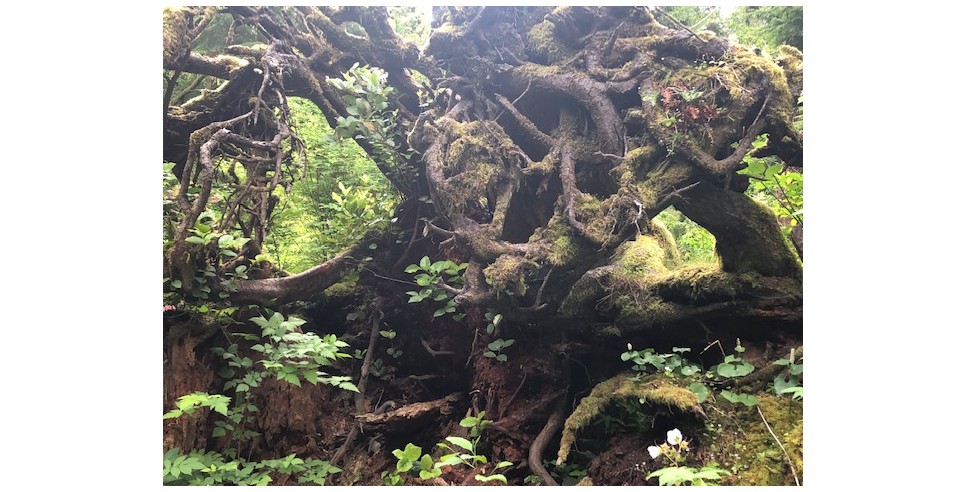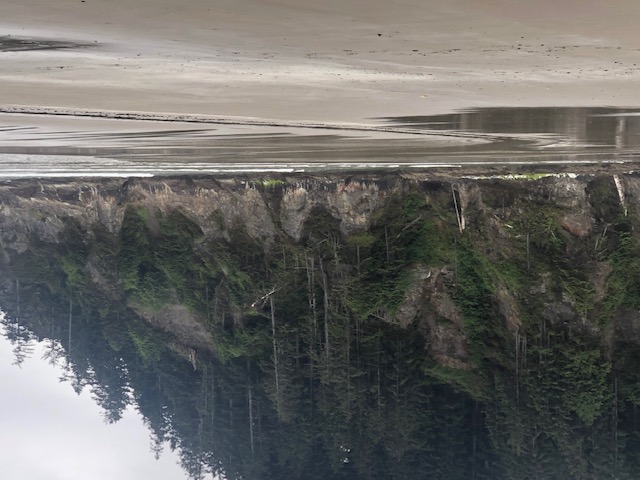
Short Sand Beach, a trail in Oregon’s Oswald West State Park, wends through a forest of old growth trees. Wild and alive for years, some say centuries, the trees do not know when the time will come—to give up life as they have known it.
Many a tree has been felled due to natural causes: lightning, merciless rain and wind, disease, old age—getting squeezed out by the sturdier specimens in the perilous life of the tree-beget-tree world.
Crashing toward the floor of the forest, one old tree lands on top of another. The fallen tree leans against the other tree for support. It’s not a sure landing and precarious at best. This marvelous tree, a Leaning Tower of Pisa, patiently waits for the next fierce wind, never knowing when it will slump to the ground at last.
One massive tree is flat on its back, preparing for its own funeral pyre, of which no one would dare strike a match. Its canopy is long gone, but when it fell, the seismic force brutally yanked its roots from the earth. Clusters of roots the size of boulders have sprung the tree a new head.
Fallen trees break apart like cigars, leaving stumps, resembling grinning trolls, prehistoric wildebeest, horned toads. The trees are beasts sparring in the thicket. Fallen trees slouch forward as if they have been stabbed in the heart. Trees fall backwards at a sharp angle as though slain by a gunshot. Trunks explode into splinters, smithereens, sawdust. The air is redolent with the sound of each crack and the deafening roar accompanying the weight of every collapse.
One tree has fallen after another, in no particular order, seemingly random to everyone and everything, except to the trees themselves.
The trees are wild with contradiction. Friends, foes, warriors, caregivers, teachers, the trees are all of these things and none of these things. They speak a language of their own.
The trees suggest they do not grieve for their fallen comrades. They know, no matter how small or how mighty a tree once stood, death is never final. Not the wind, the rain, the sun, the sky, nor the wild ocean looming ahead, can hold the trees hostage in death. Even trees carried off to sea one day return victoriously to the beach.
Every fallen tree teems with new life. Like the remains of a whale’s belly, branches splay apart in a cage of bleached and brittle bones. Golden twigs twirl in the air, tumbling toward the ground, but it is an illusion. Touched by golden threads of light, the limbs of old trees appear as delicate as silken gossamer. Tree trunks as large as elephants wear heavy coats of moss and lichen, growing fern for ears.
Under the canopy of fallen trees, young saplings proudly sprout from shell-shocked roots, stray boughs, and weather-beaten logs. They are little soldiers vying for a command position. Gnarled and twisted limbic sculptures form caves, sanctuary from the weather, new walkways, tunnels and bridges, grand infrastructure, monuments to the trees who once stood.
Many wild forms of life dwell here as if they are all together in a poem, lacking words or rhythm, and only prospering from the generous protection of trees. The trees murmur the wisdom of the ages, all that has gone before, all that is still—suspended in time—and all that is yet to come.









